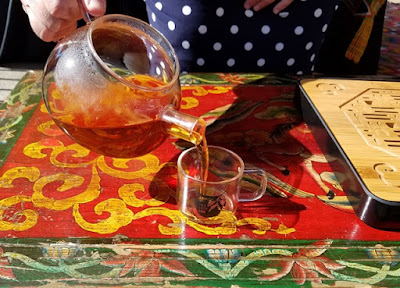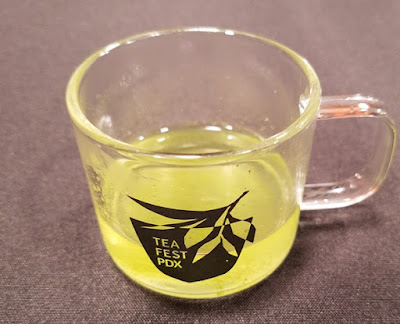The indoor and outdoor areas were filled to capacity with vendors from around the world offering a treasure trove of teas, teaware, and gifts. It was something of a challenge to see everything in between classes during this one day festival.
While ticketed tea tastings have fallen by the wayside, the outdoor vendor area offered ample opportunities to sit and enjoy impromptu tea tastings complemented by live music performances throughout the day.
Elephant Origins Tea pouring elephant friendly certified Assam
2017 Red Peony White Tea Cake made with Ruby 18 prepared by Shiuwen (Floating Leaves Tea)
Green Tea prepared by Forest (Zuo Wang Tea)
Friends of Fire tea table
Minto Island Tea Company tea processing exhibit
Prana Chai Masala Blend preserved in honey
Tao of Tea offered tastings of 500 Mile Chai in disposable-by-design kasora (also known as kulhar, kulhad, bhaar, puruas, and shikora) clay chai cups that make a satisfying "pop" when smashed.
Teapot floral arrangements with tea leaves were on display and available for purchase
Wagashi, The Art of Japanese Tea Sweets with Marjorie Yap (Issoan Tea School)
Marjorie Soya Yap has studied Urasenke tea ceremony for over thirty years and has taught for over twenty years.
Wagashi originated in Japan as fried dough prepared as an offering to the gods. During the late Edo period, wagashi gained popularity in its current form with every region having their own specialty or preference. For example, Kamakura specializes in wagashi with roasted soybean, Tokyo tends to prefer sweeter wagashi, and Kyoto specializes in milder, more refined wagashi. Wagashi prepares the mouth for matcha (powdered green tea) and does not have flavoring that lingers like mint.
Wagashi are often made from bean paste and the type used varies depending on the desired color and effect. Shiro-an (white bean paste) is commonly used and can be made from white kidney beans, butter beans, or other white beans. Coloring may be added during the wagashi making process or produced by using pastes made from more colorful beans like edamame. Anko (sweet adzuki bean paste) is often used as a filling. Pre-packaged adzuki bean paste is relatively affordable and easy to find, though it does tend to be much sweeter than what you would find in Kyoto wagashi.
While making bean paste isn't terribly labor intensive, it is a lengthy process which is why it's a good idea to make a big batch, portion it out, and freeze it for up to 3 months. The materials for this 15-person workshop took 3 days to prepare. Marjorie makes 9-10 pounds of bean paste weekly for tea ceremony classes with 1 pound of beans producing approximately 2.5 pounds of bean paste.
Wagashi are made using a variety of tools including hands, cloth, sieves, and forms (wooden or plastic). Dryer bean paste can be used when working with a mold while wetter bean paste should be used when working with hands or a sieve. Wooden forms can be soaked in water so the bean paste comes out easily, though the wood will warp over time. If you are in the market for a wagashi mold, keep in mind that bean paste tends to cling to plastic molds.
Workshop attendees received a recipe for homemade bean paste. We also received a kit containing a moistened cloth, shaping tool, freshly prepared colored shiro-an, and anko. Following step-by-step instructions, we learned how to use the provided materials to create our own wagashi which included Momo (Peach), Mukuge (Rose of Sharon), and Tessen (Clematis). My first attempt at wagashi-making (excluding sakura mochi) was a little clumsy, but they were so much fun to make.
Marjorie also shared some great reference materials for learning about wagashi which included An Almanac of Urasenke Seasonal Tea Sweets by Tomiko Sen and The Art of Wagashi by Kimiko Gunji (English, available through University of Illinois).
Making a Teapot with Jonathan Steele (Friends of Fire)
Jonathan Steele is a ceramicist, contemporary artist, and co-founder of Friends of Fire.
The class began as we passed around a teapot, beautiful and compelling in shape, color, and texture. Then we learned how much precision goes into teapot making. The spout of the teapot we had just admired tips up just enough that when it pours, the water cascades downward all over the body of the teapot instead of outward in a nice stream.
Jonathan shared tips that creators as well as buyers should know about the form and function of gongfu-style teapots. The lid and body should fit so well together that they are nearly airtight. Ideally, you could put your finger on the vent hole in the lid and water won't pour out of the spout. The best place for the spout is at the widest part of the pot which, when tilted to pour, becomes the lowest point where all the water collects. The end of the spout should be at the height of the rim of the teapot and when tipped, water should pour in a smooth stream.
We watched as Jonathan worked with an example of bisqueware that had been thrown on a wheel and trimmed into two pieces (pot and lid) before the class. He used a Japanese tool that was actually made from the tine of an umbrella to make the holes in the body for the spout. Then, he demonstrated how to make and attach the spout and handle using a mix of slip (a powdered clay material suspension in water with the consistency of frosting or heavy cream).
Cream Tea, Scones and Music hosted by Marilyn Miller (Delights of the Heart)
The British Tea Tent returned for a second year at Tea Fest PDX and I attended the afternoon Cream Tea which was accompanied by guitarist Mike Doolin.
Guests were served English Breakfast (my selection), Earl Grey, and a Ginger Lemon tisane paired with tasty chocolate chip scones from Newberg Bakery.
Japanese Green Teas 201 - Special Japanese Green Teas with Miriam Colman (Sugimoto Tea)
Miriam Colman is a Marketing Specialist for Sugimoto Tea, the US branch of Sugimoto Seicha in Shizuoka, Japan.
During this class, we had the opportunity to taste several delicious variations on Japanese green tea that most people encounter less frequently than sencha, hojicha, and genmaicha. We also learned some useful terminology.
Seicha: tea makers/processors
Asamushi: lightly steamed
Chumushi or Futsumushi: mid-steamed
Fukamushi: deep-steamed
Sencha Fukamushi
This particular deep-steamed sencha has also been deep-roasted at the finish, a Sugimoto specialty.
Gyokuro
Because the shading process required to produce gyokuro during the last few weeks of the growing period is hard on the tea plants, fertilizer is added to boost the plant health which is why organic gyokuro (our sample was not organic) is rare and challenging to produce.
Currently, most organic Japanese teas are produced in Kagoshima. In the past, Kagoshima teas were considered low quality, so many Kagoshima tea producers have made the move to organic to give them an edge in the new market.
Matcha
Miriam recommends a water temperature of 185°F which is slightly higher than what you might generally use for most Japanese green teas because whisking adds air which cools the water.
Ceremonial grade matcha is produced from the first harvest (first flush) because only the 1st and 2nd harvests are shaded. Matcha produced from later harvests is considered culinary grade.
To make matcha, tencha is dried flat, then the leaf is broken up and the veins are removed before grinding. Sencha is not good material for matcha because the leaves have been rolled, breaking the cell walls and speeding up the oxidation process which results in an unpleasant powdered tea.
Temomi Shincha
As the name suggests, temomicha (hand-rolled tea) or temomi shincha (hand-rolled first harvest tea) is made from whole tea leaves, plucked and rolled by hand. The average age of tea farmers in Japan is over 70 and most of the very few temomicha masters are reaching an age where it's no longer enjoyable to make this tea. Sugimoto is one of the few tea makers in Japan that produces temomicha and there may not be a 2020 batch, so there was a definite sense of ichigo ichie (one chance, one meeting) in experiencing this tea that many of us may never encounter again.
Miriam steeped 4 grams of tea in 100°F water for 2 minutes which produced an invigoratingly bold liquor. As one of the other attendees said after the first sip, "Woo, Tea!".
Thanks to the volunteers, presenters, and vendors for all your work in making this tea festival such a great experience!























Nice post.
ReplyDeleteThank you, Marilyn!
Delete